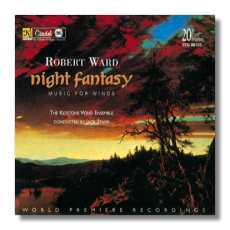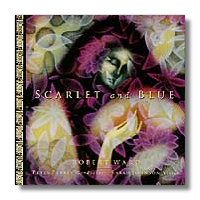
The Internet's Premier Classical Music Source
Related Links
- Latest Reviews
- More Reviews
-
By Composer
-
Collections
DVD & Blu-ray
Books
Concert Reviews
Articles/Interviews
Software
Audio
Search Amazon
Recommended Links
Site News
 CD Review
CD Review
Robert Ward

Music for Winds
- Fanfare for Durham
- Prairie Overture
- Night Fantasy
- Antiphony for Winds
- Concerto for Tenor Saxophone and Band (arr. Leist)
- 4 Abstractions for Band
- Fiesta Processional
- Fantasia for Brass Choir and Timpani
James Houlik, saxophone
Keystone Wind Ensemble/Jack Stamp
Citadel CTD88103


Scarlet and Blue
- Concerto for Violin and Orchestra
- Suite from Scarlet Letter
Sarah Johnson, violin
Winston-Salem Piedmont Triad Symphony Orchestra/Peter Perret
Albany TROY126
I have a fondness for Robert Ward, the first living composer I'd ever seen up close. I attended the Cleveland première of his opera The Crucible as, I think, a high-school student. Cleveland, of course, is hardly one of the operatic capitals (or even county seats) of the world, so it really was an event as well as somewhat quixotic of Ward to trust the première of his work to operatic part-timers. I thought the première a lovely gesture to his home town.
At one point, Ward had a thriving career as a post-Copland/Eastman School composer, but his music has just about dropped out of sight, as has Peter Mennin's, the latter once considered a fine symphonist. After careers of high-profile, first-rank commissions, both Ward and Mennin have been consigned to small, enterprising labels and regional orchestras. What happened, of course, was the rise of post-Webernian serialism as The Only Music of Our Time (accept no substitutes). Since new music gets commissioned largely for reasons of prestige, the "old hat" is shunned, and, of course, Ward didn't help himself by setting down career roots in North Carolina in bi-coastal terms, the boonies. However, fashion's winds may be blowing more eclectically nowadays. Barber and Bernstein seem to have been resurrected, with recordings of major works from major artists. Gerard Schwarz's series of American music on Delos seems to have made a dent in the classical market's buying consciousness. Perhaps the same will happen to Ward and others.
In my opinion, it turns out that Ward's Crucible crowned his career not only for its prestige - among other things, it won the Pulitzer - but also for its musical quality. Works written after the opera do not regain the intensity of either that work or those before it. What is Ward's music like, at its best? I listen to it and the phrase "very Eastman" comes to mind, but if you don't know the composers of the Eastman School, this description will mean very little. To me, Ward's music combines the Romantic lyricism of Hanson and Bernard Rogers with a dash of Prokofieff harmony and "folk" Copland for spice. I don't find him as interesting in his lyrical moments as I do his rhythmic ones. His andantes tend to put me to sleep, in fact, although I generally wake right up for his allegros.
Most of the music on these CDs comes from the late 1960s through the late 1980s, although there's enough early and middle Ward to provide an instructive contrast. The Ward of the Prairie Overture and the Fantasia for Brass Choir and Timpani has an edge that the later Ward couldn't afford to lose and unfortunately did, becoming genteel as a result. The small lyric gift became bland. The rhythmic drive practically disappeared. A great performance from committed musicians appears to be the only way the later music will work.
The Keystone Wind Ensemble does no more than an adequate job. As primarily a student ensemble (Indiana University of Pennsylvania), they don't really rise above it. A group of professionals would blow them away. They do better in the rhythmic music, like Prairie Overture (here receiving I believe its first recording in its original band version) and Antiphony for Winds. Nevertheless, the rhythm isn't as sharp as it could be; players often attack tentatively. Furthermore, they don't commit with full emotion to Ward's "Big Tunes." This hesitance may very well come down to a matter of interpretation. So many of these performances, particularly that of the Saxophone Concerto, seem limp and shapeless, which indicates problems with the director, Jack Stamp.
I should mention that the concerto comes in an arrangement - not by Ward - for wind ensemble. I also have the original version of the piece (Albany AR001), and I must say I prefer its greater instrumental contrasts and clearer, more delicate textures, although the work itself, amiable enough, fails to make much of an impression. The sax writing, traceable to the Debussy Rhapsody, fades into the wallpaper when you start thinking of what even a second-tier jazz player does with the instrument, but perhaps it's just as well that Ward didn't attempt jazz. The lyric theme of the second movement, a beguine, had its origins in a Ward try at a pop tune. It comes off like a nightclub scene in a Forties "B" musical (Cesar Romero or George Murphy plays the bandleader). Cole Porter he ain't. Yet even here the work's success, or lack of it, largely comes down to a matter of building the performance. On the Albany CD, the beguine seems less blatant, even poetic. The same soloist, Houlik, gets close to haunting you, but then he has the support of better musicians. Nevertheless, even in a clearly superior performance, the piece itself begins to take a diffident leave from your mind, just as soon as it ends.
The Violin Concerto begins gorgeously, with a sequence of unusual chord progressions, but the first movement, like the Glass violin concerto, turns out to be longer on atmosphere than on ideas. The second movement, "Blues," again tries to evoke jazz - again, the white dance music of the Forties. It succeeds better than the Saxophone Concerto, rising to the level of, say, Franz Waxman's score to The Philadelphia Story. The third movement has interesting moments which flare and die, but the concerto still adds up to mighty little. Its lack of ambition bothers me more than anything. Its successful moments recall the music Ward wrote in the 1940s, and in exactly the same terms. The music is expert and little more. I'd say the same for the ballet suite The Scarlet Letter. I'll take Ward's word that the Hawthorne novel provided the impetus, but musically and dramatically the "nice-guyness" of most of this music stands leagues away from the grim anger not only of the Hawthorne, but of Hanson's Merry Mount and Ward's own Crucible. The only apparent reason for this music is the commission. The performances by violinist Sarah Johnson and conductor Peter Perret are professional, but, as I've indicated, don't represent the composer's case, such as it is, with sufficient advocacy.
Copyright © 1997, Steve Schwartz




















